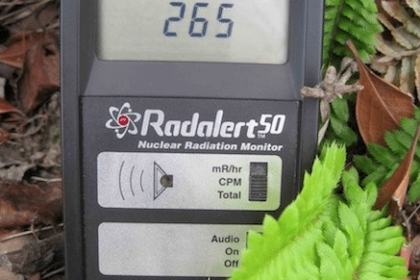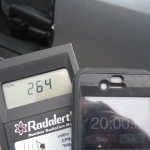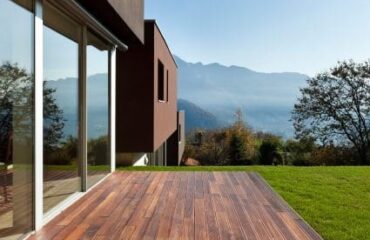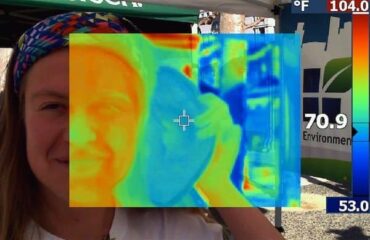Radioactive Granite and Quartzite – Risks from Radon

Radioactive Granite and Quartzite – Risks from Radon
A Green Building client of ours is busy selecting interior finishes for their new healthy home. When we get to countertops the inevitable question is asked, “Are there any health concerns about natural radioactive granite and quartzite?” The answer is yes. Some quarries are producing relatively radioactive granite and quartzite slabs and tile.
The US EPA estimates that about 21,000 Americans die of radon-caused lung cancer every year. To put that in perspective, it would take only 53 days of radon-related deaths to reach the death toll from 911.
That’s really no joke. Especially if you happen to be an organic-non-smoker caught in the hospital wondering, “how the heck did this ever happen to me?”
The answer lies underground. Uranium is an unstable radioactive element. Uranium decays in a predicable order and eventually produces radon. Radon is the invisible and odorless radioactive gas that the US EPA estimates is picking us off at the rate of +/- 57 per day.
Most significant exposures to radon are due to house design and subterranean geology. The vast majority of radon sampling is based on air testing at the lowest occupied level of the building – where radon would most likely enter the building from the ground. But there are other potential indoor sources of this invisible killer.
Some granites are radioactively “hot.” The New York Times published an article about this subject back in 2008. According a worker at one stone yard I visited, the radon-granite discovery was falsified by conspirators in the synthetic stone business to handicap sales of natural stone. Sales of natural stone (at least at this stone yard) did suffer when the radon-granite connection first became widely known.
I’ve personally used a geiger counter to test many countertops, and only a couple times have I found any significant difference when comparing granite indoors to an outside baseline. Well, this week I really found a hot potato. This was the first time the “spike” was so significant it was obvious.
Story. So I meet our client at the stone yards and we devise a testing protocol. I grab an outside baseline (control) sample. We use the Building Biology threshold limits and simply place a geiger counter near several slabs to see what happens. Granted we’re inside a building (possible ground-source radon) that is full of granite slabs (other sources), and we’re taking a limited number of short-term readings, so statistically this study leaves much to be desired. But at the first stone yard all the measurements indoors were no more than 6% greater than the outside control sample. This seemed reasonable and the relationship became predictable. There were no “spikes.” 50% or greater warrants a fail according to the Building Biology threshold, so all these stones passed.
Now comes the second stone yard the following day. The outside baseline sample was nearly identical, but all the measurements indoors were significantly higher. All of the slabs the client was interested in were below the Building Biology threshold, but our interest was raised. [Oh how I’d love to do a traditional radon test in this warehouse!]
One of the attendants was kind enough to show me an orangish/red granite and indicated that when all the hub-ub was originally made it was around this particular type of granite. It was labeled Crema Bordeaux: Granite.
So I put the meter at the base of the slab as I had all the other slabs, and to my surprise the geiger counter starts chirping noticeably faster. The outside baseline was around 14 counts per minute, and at the base of the Crema Bordeaux it was humming at 42 counts per minute.
How dangerous is that? We know that ionizing radiation causes us harm. I like to refer to the Building Biology moto, “nature is the ultimate goal,” and “any reduction in contamination is worthwhile.” So whenever possible I would recommend reducing exposure to this source of ionizing radiation.
My experiment was very simple and did not account for many uncontrolled variables, but the results were rather stunning. I was lead to a particular slab that the stone yard guy said was the source of radon controversy several years ago – and Whamo – the meter spikes. Coincidence? I think not.
To close I’m going to share the horror story I was told when learning this testing method. A Building Biologist was testing a home and got a radioactive spike off a granite countertop. He didn’t say anything at first and ran a second round of tests while continuing with the environmental inspection. The second results showed a significant spike again. He mentioned this finding to the homeowner who was leaning against the counter during the conversation.
Her face changed immediately and she took a step back from the counter before raising the bottom half of her shirt to reveal a 4″ scar.
This client had a tumor removed from her belly at the exact same height as where she leaned up against the counter when she worked in the kitchen. What caused the cancer we’ll never know. Was this just another coincidence? She didn’t care.
Why not exercise precaution around this material. Granite is a lovely, durable, and readily available building material. But before you bring it into your healthy habitat have it checked out.
NOTE: We are the first to admit there are better ways of measuring radioactivity in bulk samples, but this simplified method makes for an affordable quick screening process for radioactive granite and quartzite.









